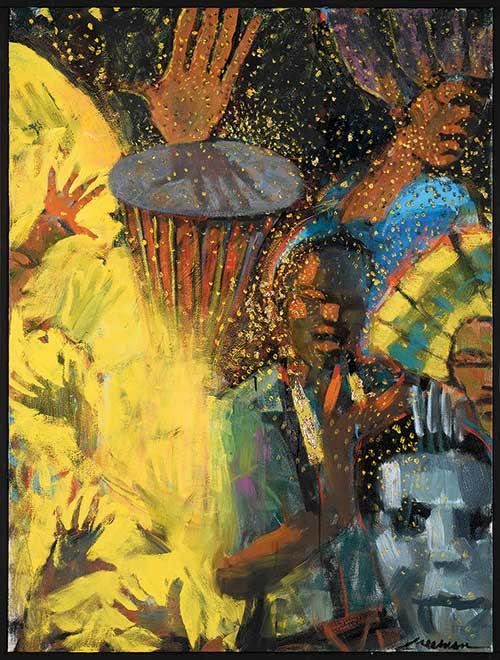The Magic of Mardi Gras
Adelson Galleries exhibit celebrates New Orleans

Artist Robert Freeman had been a fan of photographer Max Stern’s work for some time before they visited New Orleans together in March of 2017. Inspired by Stern’s vivid pictures of black Indians in celebratory costume, Freeman asked to come with him on Super Sunday — a day of processions in New Orleans in mid-March — to learn about the culture. “Mardi Gras Indians,” showing at Adelson Galleries through April 29, showcases the stunning artistic collaboration that resulted.

Author: Courtesy Adelson GalleriesPercussion, feathers and fancy clothes are featured prominently in traditional Mardi Gras celebrations.
The Mardi Gras (or “Black”) Indians trace their roots back to Native Americans who shielded runaway slaves. African Americans had trouble joining early Mardi Gras organizations, called “krewes,” and so they formed their own based on their unique heritage. Now they’re known for their ornate costumes, which are made by the men of the krewes, Freeman notes.
On the web
To learn more about Robert Freeman and the “Mardi Gras Indians” exhibit, visit: www.adelsongalleriesboston.com

Author: Courtesy Adelson GalleriesImages from the Adelson Galleries’ exhibit of Robert Freeman’s Mardi Gras Indian paintings.

Author: Courtesy Adelson GalleriesImages from the Adelson Galleries’ exhibit of Robert Freeman’s Mardi Gras Indian paintings.

Author: Courtesy Adelson GalleriesImages from the Adelson Galleries’ exhibit of Robert Freeman’s Mardi Gras Indian paintings.
Freeman has a long history of painting African American party scenes. His “Black Tie” series showed black high society in full swing. In New Orleans he recognized elements similar to his own heritage. “The bright colors in the dress, the feathers and the white painted faces reminded me of West Africa,” he says. “The three cultures started to blend.”
Gallery co-owner Adam Adelson describes Freeman’s work as the emotional illustration of the festivities and Stern’s work as the details of the celebration. Stern’s close-up, candid portraits reveal the intricate beadwork of the costumes, and the at-once serious and joyful faces of the performers. Adelson says, “Our objective all along was to introduce this unique part of American culture to the Boston audience.” The exhibit debuts during the 300th anniversary of New Orleans’s founding, though not planned as such.
Freeman’s abstract brush strokes flourish in depicting the movement of dancers and revelers. In these paintings he also begins to use other media, incorporating ostrich feathers and using more heavily the gold leaf that appeared in his “Ashanti” series. “For the first time I was using mixed media,” he says. “There was this artistic challenge of not letting one element overpower the other.”
His works in the exhibit run the gamut, from a more traditional piece of three women in red dresses, to a wild, abstract piece representing the spiritual coming together of life and death, a popular theme during Mardi Gras.
Freeman’s goal is to intrigue people, whether they are familiar with the Mardi Gras Indians or not. He hopes his viewers have an emotional reaction to the work. He says, “I hope someone stands in front of one of these paintings and can’t look away because their heart is drawn to it.”




![Banner [Virtual] Art Gallery](https://baystatebanner.com/wp-content/uploads/2024/04/NJ-H_1-713x848.jpg)

